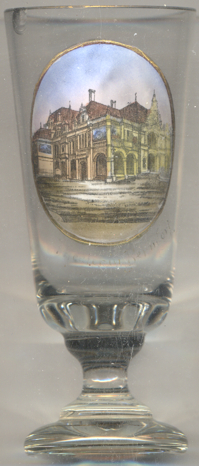

|
| ÖSTERREICH | AUSTRIA |
| Bundesland: Niederösterreich | Lower Austria |
| Bezirk: Baden |
 Berndorf is situated at an elevation of 314 m in the Triesting valley of Lower Austria. the municipality has a
population of about 9,100 (2018).
Berndorf is situated at an elevation of 314 m in the Triesting valley of Lower Austria. the municipality has a
population of about 9,100 (2018).
Perendorf was first mentioned in a document dating from 1133. In the 18th century, metal-working companies such as Neuhirtenberger Kupferhammer, which used the first steam engine in all of Lower Austria in 1836, settled in this region. Before that, hydropower coming from the river Triesting was the main energy source. In the 19th century the majority of the inhabitants of Berndorf and its neighbouring villages worked in the metal industry. In 1844, when the cutlery factory of Alexander Schoeller and Hermann Krupp was founded, Berndorf consisted of no more than 50 houses with about 180 inhabitants. Initially, there were 50 workers, but throughout the years, the company developed and turned into a multi-national combine with over 6,000 employees. The development of the city of Berndorf was closely related to the history of the Krupp family. Arthur Krupp, son of Hermann Krupp, founded a private elementary school and a public swimming pool, as well as the neo-Baroque St. Margaret's church. In 1923, the communities of Berndorf, St. Veit, Ödlitz and Veitsau were merged into the new city of Berndorf. After the Anschluss in 1938, the Arthur Krupp company became a part of the German Krupp combine (see e.g. Essen). Because of its industrial importance, Berndorf was also an important target of air attacks. During World War II, Berndorf was not even spared the forces of nature. The floods in 1939 and 1944 were the most destructive floods in the history of the Triesting river. After the war, the metal company was confiscated by the Soviet Army and incorporated into the Administration for Soviet Property in Austria. In 1957, it was given back to the State of Austria and merged with the Vereinigte Aluminiumwerke Ranshofen. Because of financial problems of the socialised industries in the 1980s, the Berndorf consortium was spun off and passed into private hands.
The  municipal theatre [left, no. 3654]
was donated by Arthur Krupp on the occasion of Emperor Franz Joseph's 50th anniversary as Austrian regent. The theatre
was built in 1897/1898 by the famous Austrian theatre architects Ferdinand Fellner jr. and Hermann Helmer in
Historistic Renaissance and Rococo revical style. Originally, the exterior was decorated by colourful frescos of which,
however, only parts remain. Although the construction of the theatre was completed in time, the opening was postponed to
the following year as on 27 September 1998 Empress Elisabeth had been assassinated in Geneva.
Damaged by a fire in 1902, it was restored in 1903 following the riginal designs. Damaged by the bombings of 1944 and by
the flooding of the river Triesting in the sae year, the theatre thereafter was neglected. In 1960 it was donated to the
municipality of Berndorf. A renovation was carried out in 1960–1964, followed by another one in 1988–1992.
Today, the theatre has a capacity of 488 seats. Since 1989 it is the venue for the festival 'Berndorfer Theatersommer'.
municipal theatre [left, no. 3654]
was donated by Arthur Krupp on the occasion of Emperor Franz Joseph's 50th anniversary as Austrian regent. The theatre
was built in 1897/1898 by the famous Austrian theatre architects Ferdinand Fellner jr. and Hermann Helmer in
Historistic Renaissance and Rococo revical style. Originally, the exterior was decorated by colourful frescos of which,
however, only parts remain. Although the construction of the theatre was completed in time, the opening was postponed to
the following year as on 27 September 1998 Empress Elisabeth had been assassinated in Geneva.
Damaged by a fire in 1902, it was restored in 1903 following the riginal designs. Damaged by the bombings of 1944 and by
the flooding of the river Triesting in the sae year, the theatre thereafter was neglected. In 1960 it was donated to the
municipality of Berndorf. A renovation was carried out in 1960–1964, followed by another one in 1988–1992.
Today, the theatre has a capacity of 488 seats. Since 1989 it is the venue for the festival 'Berndorfer Theatersommer'.
(See also list of further theatres and other buildings designed by Fellner and
Helmer, which are depicted on glasses of this collection.)
[https://de.wikipedia.org/wiki/Berndorf_(Niederösterreich), https://en.wikipedia.org/wiki/Berndorf,_Lower_Austria;
https://de.wikipedia.org/wiki/Stadttheater_Berndorf]
![[scale]](lineal.jpg)